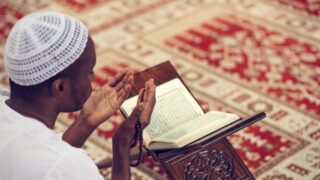The name of the Taraweeh prayer prevails over the prayers that are performed on the nights of Ramadan because the imam sits after every four rak’at. It is said that he sits between each two rak’ahs, the amount of Tarweehah – a break.
Taraweeh is a plural of Tarweehah, meaning a break. He said in Al-Qamus: Tarweehah in the month of Ramadan was named for a break after every four rak’ahs – it is said: istarwaha, meaning he found rest. The origin of Taraweeh appears as one of the traditions that the Messenger, may God bless him and grant him peace, persisted on. It was reported by Al-Bayhaqi in his book (Al-Sunan Al-Kubra) with his chain from ‘Aishah, may Allah be pleased, that she said: “The messenger of Allah used to pray four raka’ats in the night then he would rest. Then he would prolong it until I pitied him and I said: for you is my father and mother O Messenger of God, Allah has forgiven you for the past and late of your sins. He said: Should I not be a grateful slave. ”
Al-Bayhaqi said about the hadith: “Al-Mughira ibn Ziyad singly reported it, and he is not that strong, and his saying: “Then he would rest”, if proven, then it is the basis for the imam to rest in the Taraweeh prayer. [Al-Sunan Al-Kubra by Al-Bayhaqi (2/700)].
It has been proven in authentic hadiths that the Messenger, may God bless him and grant him peace, performed Taraweeh during the nights of Ramadan. These include:
– The first hadith: The hadith of Abu Hurairah. He said: “The Messenger of God, may God’s prayers and peace be upon him, wanted to start Ramadan without determined command. He said:“ Whoever performs Ramadan with faith and expectation, his previous sins will be forgiven. ” Narrated by the Al-jama’ah.
This hadith explicitly states that the Prophet, peace and blessings of God be upon him, was keen on performing Taraweeh prayers in Ramadan and encouraging the Companions and the Ummah to observe it, and this is understood from the reward that results from performing it.
– The second hadith: the hadith of Aisha. Aishah (May Allah be pleased with her) reported:
The Messenger of Allah (may the peace and blessing of Allah be upon him) did not observe more than eleven Rak’ah (of Tahajjud prayers), be it in Ramadan or any other month. First of all he would perform four Rak’ah. Ask not about their excellence and their length. He (may the peace and blessing of Allah be upon him) would then perform four more Rak’ah; and do not ask about their excellence and their length. Then he would perform three Rak’ah…[Al-Bukhari (1147) and Muslim (738)).
– The third hadith: The hadith of Abu Dhar al-Ghifari, may God be pleased with him, he said: We fasted Ramadan with the Messenger of Allah and he did not lead us in praying Qiyam (prayers at night) during any part of it, until there were seven nights left. He led us in praying Qiyam on the seventh night until approximately one third of the night had passed. Then on the sixth night which followed it he did not lead us in prayer. Then he led us in praying Qiyam on the fifth night which followed it until almost half the night had passed. I said: ‘O Messenger of Allah, would you lead us in voluntary prayer the rest of the night.’ He said: ‘Whoever stands with the Imam until he finishes, it is equivalent to spending the whole night in prayer.’ Then he did not lead us in prayer, until it remained three days from the month, he led us in prayer for the third time, when he gathered his wives and family, and he led us in prayer until we feared that we would miss the Falah.” It was asked: “What is the Falah?” He said: “Suhur.” It was authenticated by Al-Albaani in “ Solaatut- Taraweeh” (p. 15)].
This indicates the virtue of performing Taraweeh prayers with the imam.
It was reported in “masaail of Abu Dawood: I heard Ahmed bin Hanbal when he was told: Would you like a man to pray with the people in Ramadan or alone? He said: He prays with the people, and I also heard him saying: I like him to pray with the imam and pray witr with him. The Prophet, peace and blessings be upon him, said: “If a man performs this prayer with the imam until he finishes, God will record for him the rest of his night” [Abi Dawood’s Questions: P.62].
The number of Rak’ah for Taraweeh prayer
In Aisha’s previous hadith, we find the clear explanation of how the Prophet, may God’s blessing and peace be upon him, prayed Tarawih prayers in Ramadan. Despite its clarity, the jurists differed in the interpretation of this description of the actions of the Prophet, may God bless him and grant him peace, especially with the addition of different narrations that were mentioned in the description of the Prophet’s Taraweeh in Ramadan. We shall stop to explain the hadith of Aisha, may God be pleased with her.
1 – That the Messenger, may God’s blessing and peace be upon him, did not exceed eleven rak’ahs in his prayer at night, whether in Ramadan or otherwise. This meaning is confirmed if we realize that the Prophet’s prayer at night, regardless of their different names, does not exceed the number mentioned. Al-Mubarakfouri said: Taraweeh, qiyaam in Ramadan, night prayers and tahajjud prayer in Ramadan are one thing, and a name for one prayer. Tahajjud in Ramadan is not other than Taraweeh because it was not proven from a correct or weak narration that the Prophet, peace and blessings be upon him, prayed two prayers during the nights of Ramadan which one of them Taraweeh, and the other Tahajjud. Therefore, tahajjud (tahajjud) in times other than Ramadan is Taraweeh in Ramadan. “Mir’aatul mafatih, Explanation of Mishkat al-Misbah” (4/311).
2 – That the Messenger, may God’s blessings and peace be upon him, never failed to pray the night prayer in Ramadan and elsewhere, at home or on travel, unless he fell asleep or fell in pain, and this indicates that Taraweeh is included in the absolute night prayer, so he, peace and blessings be upon him, continued on it. [Zadul ma’ad: 4/380].
3 – The rak’ahs that the Messenger, may God bless him and grant him peace, prayed, which are eleven rak’ahs, include eight rak’ahs of voluntary prayer (nawafil) and taraweeh, and then he would observe three other rak’ahs as witr. This makes it eleven rakahs. This meaning is confirmed in the narration of Jabir bin Abdullah: the messenger of Allah led us in eight rakats prayer in the month of Ramadan and observed Witr… ”. This hadith and that of Aishah are in concordance among the examiners (analytical scholars) from the scholars of Hadith and fiqh (jurist). None of them said that the Prophet, peace and blessings of God be upon him, prayed more than eight rak’ahs in Ramadan or other than Ramadan, but the difference is in length, reading, time, congregation, and so on. (2)
4 – As for the hadiths that mentioned that the Messenger, may God bless him and grant him peace, prayed more than eleven rak’ahs, the correct view is that they included other Sunnahs, such as: The Sunnah of the two rak’ahs of Fajr. It came from al-Sha’bi that he said: I asked Abdullah bin Abbas and Abdullah bin Omar about the prayer of the Messenger of God – May God bless him and grant him peace – at night, so they said: “Thirteen, from it is eight, and three witr rak’ahs, and two rak’ahs after dawn.” That is, after entering the time of dawn.
What was the guidance of Prophet in Taraweeh prayer?
One of the guidance of the Messenger of God (may God bless him and grant him peace) in the night prayer was that his prayer begins at the beginning of the night. He prays four or six rak’ahs, according to what is convenient to him, then sleeps for a while. The most correct of these rak’ahs is that it is the Sunnah of the Isha prayer because he used to pray it in his home after dinner, and then lie down.
Sometimes he wakes up in the middle of the night, shortly before or shortly after, and perform the worship of the night, which is Taraweeh. When he woke up, he used to start with the miswak, then remember God with what he used to say when he woke up (i.e. the last ten verses of Al Imran), then purify himself, and then pray two light rak’ahs. Aisha said. May God be pleased with her: The Messenger of God – may God bless him and grant him peace – used to rise from the night with two light rak’ahs [4] .
He used to pray eight rak’ahs with the first two light rak’ahs in the Qiyaam al-Layl prayer, and this is the first type that is established by Aisha, may God be pleased with her. He used to say “tasleem” in every two rak’ahs and observe witr with one rak’ah to make it eleven raka’ahs
There are other forms for the number of rak’ahs that the Messenger of God prayed in his prayer at night, which Ibn al-Qayyim, in addition to the narration of Aisha, may God be pleased with her, counted up to seven types [5] .
What was the Prophet’s guidance in Taraweeh’s recitation and Qunoot?
And it was not proven that the Prophet, may God bless him and grant him peace, performed Qunoot during Witr prayer. Ahmad said: Nothing is narrated in the Qunoot of Witr from the Prophet, may God bless him and grant him peace, but Umar used to recite it from year to year. The Qunoot prayer of witr was more established among the Companions, may God be pleased with them, than the Qunoot of Fajr. Ibn al-Qayyim said: The Qunoot in Witr is known from Umar, Ubayy and Ibn Masoud, and the narration from them in it is confirmed than the qunoot at dawn. Conversely, the qunoot of dawn is confirmed with the Prophet, peace and blessings be upon him, than the narration in Qunoot of witr. [Zadul ma’ad: 1/397].
The recitation of the Prophet, peace and blessings of God be upon him, in the night prayers was of measured pace, reflecting on each verse. He would stop at the end of the verses. If the verse related to what followed he might pause, repeat the verse, and ponder on its meaning until the morning. Ibn al-Qayyim said: This is the best, and some of the readers went on to follow the purposes and intentions. Following the guidance of the Messenger of God – may God bless him and grant him peace – and his Sunnah is the best. [ Zadul ma’ad: 1/401].
The Messenger of God, may God bless him and grant him peace, used to read the Qur’an silently at night prayers sometimes, and loudly sometimes, prolonging the standing sometimes, and relieving it at other times. He performed Witr at the end of the night (which is the most), beginning at times and in the middle at other times.
This statement reflects the guidance of the Messenger, may God’s blessing and peace be upon him, in adopting what is easier and not being impatient. The Muslim takes what is easy for him and does not miss the merit of the Ramadan qiyaam due to the inability to prolong the recitation. Each one takes what he can and continues to do it. And the guidance of the Prophet accommodated all of that.


















